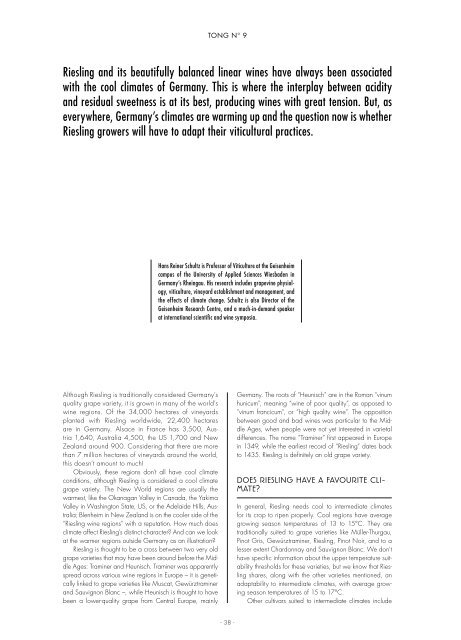TONG N° 9Gironde would plant a Pinot Noir or Chardonnay t<strong>here</strong>.A-propos Bordeaux, no one would complain that inthe middle of the Graves region, w<strong>here</strong> you find the PremierGrand Cru Classé producer Château Haut-Brion, youalso find the Sauternes appellation, w<strong>here</strong> another PremierCru producer Château d’Yquem produces a totally diversesweet wine style from a different array of white grape varieties.Thus it makes sense that in the Mosel, w<strong>here</strong> thesteep-sloped slate terroirs have an unrivalled potential forproducing some of the most exquisite sweet wines in theworld, their “Erste Lage” vineyards express themselves bestin a fruity Spätlese or Auslese style. It would be a pity toforce them to express this potential only in a dry “GrossesGewächs” style, in the same way as it would be a shameto produce dry Cabernet Sauvignon red wines under theSauternes appellation.Some critics of “Grosses Gewächs”, including mostrecently Gerhard Eichelmann, the author of an influentialwine guide in Germany [3], compare the young and stilldeveloping VDP classification system with its long-establishedBordeaux and Burgundy counterparts. Singling out“Erste Lage”, “Grosses Gewächs” and “Erstes Gewächs”,embracing dry and sweet wines, he neglects the crucialfact that the VDP classification system is attempting to unite13 viticultural regions with different wine traditions developedover centuries. Furthermore, he attacks VDP membersoffering icon wines at higher prices than their regular“Grosses Gewächs” wines.However, why is Klaus Peter Keller’s G-MAX Rieslingimmoral when a Cabernet Sauvignon-based Ornellaia orSassicaia are hailed as Super Tuscans, although they circumventtraditional winemaking prescriptions and neglectthe local hero Sangiovese?If a classification system is mainly based on the qualitypotential of vineyards, the term terroir becomes the centralissue. According to the website of the VDP, each of thethree tiers of the quality pyramid is associated with a specificdegree of terroir expression. “Erste Lage” wines shouldexpress “discernible terroir”; second-tier wines should beabout “distinctive terroir”; and third-tier estate wines shoulddeliver “a hint of terroir”. So we need a definition of terroirand more importantly a proof that terroir really mattersand translates into wines via different quality and sensoryexpression.Terroir expression of a wine should be defined as theperceptible sensory dimension of the interactions betweenthe grapevines, the geological and pedological factorsof a site, the latter’s topography, and site-specific climaticconditions. Although this definition excludes anthropogenicelements, terroir cannot be isolated from human activity,as viticultural and oenological procedures may enhanceand sometimes suppress terroir expression of the winesproduced from these terroirs [3].According to the VDP, “Three components determineterroir…(1) the overall quality and character of a vineyardsite; (2) the skill of the grower; and (3) the quality of avintage. Terroir is recognisable in a wine. The quality ofa vineyard is defined by its soil (topographical position,climate and microclimate). Only some grape varieties arewell suited to a specific terroir”[1]. Comparing both definitions,divergence is only marginal and limited to the notionof vintage. With close inspection, vintage effects are mainlyexpressed via the impact of climatic conditions, whichare part of the scientific definition as well.The VDP members agree on the crucial sensory dimensionof terroir. None of their “Erste Lage” or “GrossesGewächs” wines will receive this prestigious designation,unless in at least two blind tastings the quality and terroirexpression was approved by their peers. As always, whenhuman assessment is involved, especially in such an emoregionAhrBadenFrankenMoselMittelrheinNahePfalzRheingauHess. Bergst.RheinhessenSachsenSaale-UnstrutWürttembergsumgrapevarietyRiesling • • • • • • • • • • • • • 13Grauburgunder • • 2Weißburgunder • • • • • • • • 8Silvaner • • 2Spätburgunder • • • • • • • • • • 10Frühburgunder • 1Lemberger • 1number ofgrape varieties 3 4 4 1 1 1 3 2 4 3 3 4 4(table 2) Regionally selected grape varieties for “Erste Lage” winesBack to the real world: the second tier offers wines fromvineyards classified by the regional VDP members as a“small group of traditional vineyards with a distinctivecharacter” [1]. In order to differentiate wines from secondvineyards versus those from first-tier “Erste Lagen”, you haveto combine the vineyard designation with its village name(f.e. Graacher Himmelreich). In contrast, a growing numberof wine estates restrict their “Erste Lage” labels to the vineyarddesignation alone (see figure 3), not mentioning avillage name (f.e. Josephshöfer). Still, the major distinctionis the use of the logo, which is reserved for first-tierwines only.Recently, some second-tier wines have been labelled withouta vineyard designation, using instead the predominantbedrock type of the vineyard. These vary from slate varietiessuch as grey, red or blue slate, porphyr, buntsandstein(blunder), limestone or shell limestone, basalt, gypsum orvolcanic rock. This approach makes it easy to understandthe link between wine and soil, and it also circumnavigatesa trap contained in the VDP rules. Single vineyarddesignations can be as large as several hundred hectares,and not each lot in this designation is able to produce“Erste Lage” wines. However, if a wine produced from asuperior lot is already marketed as “Erste Lage” wine, thissingle vineyard designation can no longer be used for asecond-tier wine. Thus a growing number of wine estatesuse this terroir approach, or more precisely bedrock, tolabel these second-tier wines with a more distinct qualitycognition than a simple village designation. These areoften used for second-tier wines, which need to be offeredin larger quantities to meet the demand of large nationaldistributors and international importers of VDP wines.Third-tier wines are everyday drinking wines that reflectthe style of the wine estate as well as regional character.Terroir is the focal point- 32 -
TONG N° 9Riesling and its beautifully balanced linear wines have always been associatedwith the cool climates of Germany. This is w<strong>here</strong> the interplay between acidityand residual sweetness is at its best, producing wines with great tension. But, aseveryw<strong>here</strong>, Germany’s climates are warming up and the question now is whetherRiesling growers will have to adapt their viticultural practices.Hans Reiner Schultz is Professor of Viticulture at the Geisenheimcampus of the University of Applied Sciences Wiesbaden inGermany’s Rheingau. His research includes grapevine physiology,viticulture, vineyard establishment and management, andthe effects of climate change. Schultz is also Director of theGeisenheim Research Centre, and a much-in-demand speakerat international scientific and wine symposia.Although Riesling is traditionally considered Germany’squality grape variety, it is grown in many of the world’swine regions. Of the 34,000 hectares of vineyardsplanted with Riesling worldwide, 22,400 hectaresare in Germany. Alsace in France has 3,500, Austria1,640, Australia 4,500, the US 1,700 and NewZealand around 900. Considering that t<strong>here</strong> are morethan 7 million hectares of vineyards around the world,this doesn’t amount to much!Obviously, these regions don’t all have cool climateconditions, although Riesling is considered a cool climategrape variety. The New World regions are usually thewarmest, like the Okanagan Valley in Canada, the YakimaValley in Washington State, US, or the Adelaide Hills, Australia;Blenheim in New Zealand is on the cooler side of the“Riesling wine regions” with a reputation. How much doesclimate affect Riesling’s distinct character? And can we lookat the warmer regions outside Germany as an illustration?Riesling is thought to be a cross between two very oldgrape varieties that may have been around before the MiddleAges: Traminer and Heunisch. Traminer was apparentlyspread across various wine regions in Europe – it is geneticallylinked to grape varieties like Muscat, Gewürztraminerand Sauvignon Blanc –, while Heunisch is thought to havebeen a lower-quality grape from Central Europe, mainlyGermany. The roots of “Heunisch” are in the Roman “vinumhunicum”, meaning “wine of poor quality”, as opposed to“vinum francicum”, or “high quality wine”. The oppositionbetween good and bad wines was particular to the MiddleAges, when people were not yet interested in varietaldifferences. The name “Traminer” first appeared in Europein 1349, while the earliest record of “Riesling” dates backto 1435. Riesling is definitely an old grape variety.Does Riesling have a favourite climate?In general, Riesling needs cool to intermediate climatesfor its crop to ripen properly. Cool regions have averagegrowing season temperatures of 13 to 15°C. They aretraditionally suited to grape varieties like Müller-Thurgau,Pinot Gris, Gewürztraminer, Riesling, Pinot Noir, and to alesser extent Chardonnay and Sauvignon Blanc. We don’thave specific information about the upper temperature suitabilitythresholds for these varieties, but we know that Rieslingshares, along with the other varieties mentioned, anadaptability to intermediate climates, with average growingseason temperatures of 15 to 17°C.Other cultivars suited to intermediate climates include- 38 -





